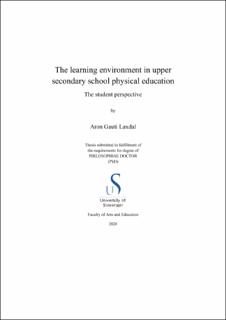| dc.contributor.author | Laxdal, Aron Gauti | |
| dc.date.accessioned | 2020-06-12T08:49:53Z | |
| dc.date.available | 2020-06-12T08:49:53Z | |
| dc.date.issued | 2020-06 | |
| dc.identifier.citation | The learning environment in upper secondary school physical education: The student perspective by Aron Gauti Laxdal, Stavanger : University of Stavanger, 2020 (PhD thesis UiS, no. 513) | en_US |
| dc.identifier.isbn | 978-82-7644-920-4 | |
| dc.identifier.issn | 1890-1387 | |
| dc.identifier.uri | https://hdl.handle.net/11250/2657854 | |
| dc.description.abstract | The overreaching aim of this thesis was to gain a better understanding of the students’ perceptions of the learning environment in upper secondary school physical education, with special focus on marginalized subgroups. More specifically, the intention was to explore whether students perceived their learning environment differently depending on their teachers’ gender, the learning support they received or the perceived competence they had. Despite the learning environment being a well-researched phenomenon in the more academic school subjects, there was a substantial knowledge gap concerning its influence in physical education. The individual works that form this ensemble aimed to occlude some of those gaps. In an effort to achieve the aforementioned aims, a new instrument measuring teacher learning support in the physical education context was also constructed and validated.
The chosen methodology for the thesis was cross-sectional, comprising of a multicomponent self-report questionnaire. The data was analyzed using various analytical tools, including structural modeling analysis and MANCOVA between group comparisons. The participants were 1133 upper secondary school students (Mage = 17.2, SD = 0.86) from Norway (n = 554) and Iceland (n = 579), and 17 Norwegian PE teachers (11 males, 6 females). The sampling of participants was performed using a stratified procedure representing both urban, suburban and rural settlements. Multiple steps were taken to ensure adequate sample representability.
The collective results of the individual papers indicate that the current organizational trends in PE are more in line with the needs of the highly competent students, and less so with the needs of the less competent students. This tendency intensifies the differences between these groups and may be one of the primary drivers behind the negative relationship between age and appreciation for the subject. Further, the students do not appear to be self-regulating their learning to the same extent as they are in other subjects, despite the teachers efforts to facilitate the behavior. The cause of this discrepancy likely being PE’s reputation as a recreational subject, underlined by the absence of homework and the playful nature of the lessons. Additionally, the role of the teacher’s gender in influencing the PE experience seems to be exaggerated. Gender matching and positive discrimination of female PE teachers are therefore unlikely to improve the learning environment of female students.
The concluding recommendations are multitudinous and include suggestions to all the stakeholders of the subject. They include an appeal to the policymakers to rely more heavily on the body of research when implementing or adjusting policy, a plea to the teaching institutions educating the physical education teachers to emphasize formative teaching practices to a greater extent in their program, in order to promote learning behavior, and a call to the physical education teachers to address the various challenges related to the less interested and less competent students by reducing the benefits of sporting experience and ameliorating the current curriculum implementations by introducing more non-traditional sports and activities. | en_US |
| dc.language.iso | eng | en_US |
| dc.publisher | University of Stavanger, Norway | en_US |
| dc.relation.ispartofseries | PhD thesis UiS; | |
| dc.relation.ispartofseries | ;513 | |
| dc.relation.haspart | Paper 1: Laxdal, A., Mjåtveit, A., Leibinger, E., Haugen, T., & Giske, R. (2019). Self-regulated learning in physical education: An analysis of perceived teacher learning support and perceived motivational climate as context dependent predictors in upper secondary school, Scandinavian Journal of Education Research, 1-13. | en_US |
| dc.relation.haspart | Laxdal, A., & Giske, R. (2019). Gender and the perceived learning environment in upper secondary school physical education, Sport, Education and Society, 1-9. | en_US |
| dc.relation.haspart | Laxdal, A., Johannsson, E., & Giske, R. (in press). The role of perceived competence in determining teacher support in upper secondary school physical education, The Physical Educator (Submitted version) | en_US |
| dc.rights | Copyright the author, all right reserved | |
| dc.rights | Navngivelse 4.0 Internasjonal | * |
| dc.rights.uri | http://creativecommons.org/licenses/by/4.0/deed.no | * |
| dc.subject | utdanningsvitenskap | en_US |
| dc.subject | kroppsøving | en_US |
| dc.subject | physical education | en_US |
| dc.subject | gymlærere | en_US |
| dc.subject | kjønnsroller | en_US |
| dc.title | The learning environment in upper secondary school physical education: The student perspective | en_US |
| dc.type | Doctoral thesis | en_US |
| dc.rights.holder | © 2020 Aron Gauti Laxdal | en_US |
| dc.subject.nsi | PhD thesis in Educational Sciences | en_US |
| dc.subject.nsi | VDP::Social science: 200::Education: 280 | en_US |

